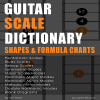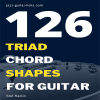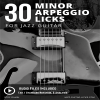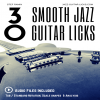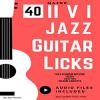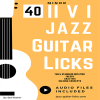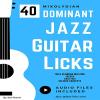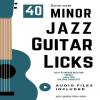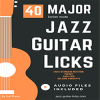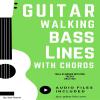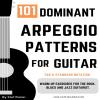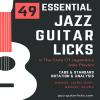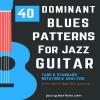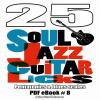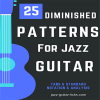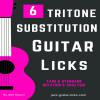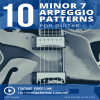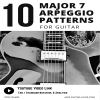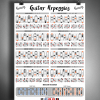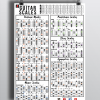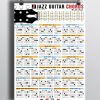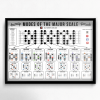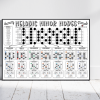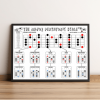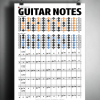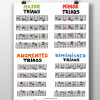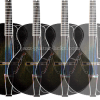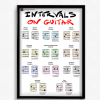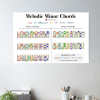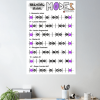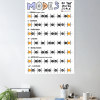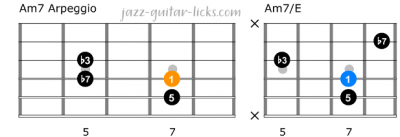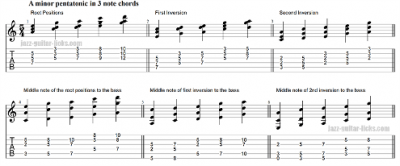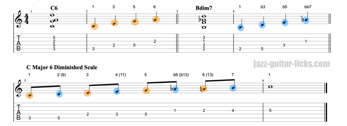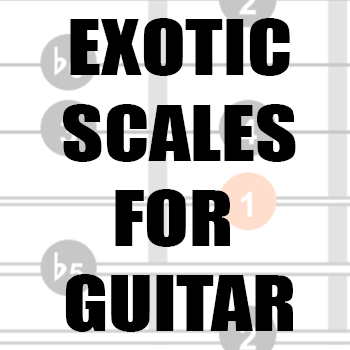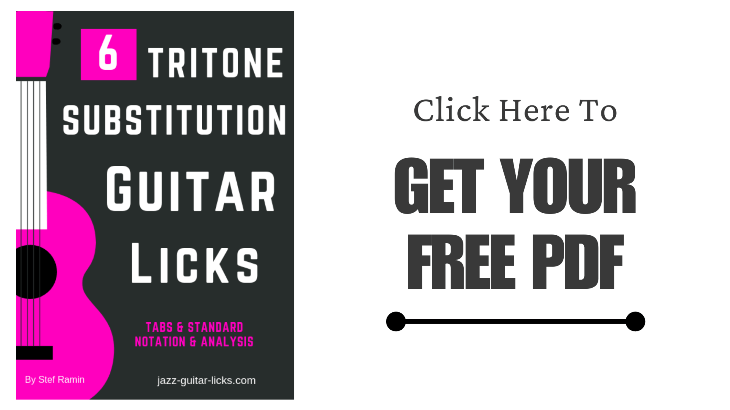List of Musical Intervals - Music Theory
- By jazz-guitar-licks
- On 2017-04-06
- In Music Theory
- 2 comments
Intervals are the building blocks of melody and harmony—the distances between two pitches.
Understanding intervals helps you recognize and create musical relationships, build chords, and develop more expressive solos.
In this lesson, we’ll explore the full spectrum of intervals, from the smallest step (a minor 2nd) to the expansive leap (an octave and beyond).
By mastering intervals, you’ll improve your ear and your understanding of how music works underneath the surface.
What is an Interval ?
An interval is the distance between two notes, each one is represented by a number (1,2,3,4,5,6,7...) and a prefix related to its quality ("M" for major, m for minor, "P" for perfect, "d" for diminished and "A" for augmented).
There are five different qualities.
An interval can be melodic, when the tones are successive (played one after the other) and harmonic, if the notes are stacked (played simultaneously).
Knowing the name of each interval on guitar and on any other instrument is very important.
Intervals are essential elements of music theory.
They are very useful to understand how chords and scales are built.
Interval Names - Simple and Compound
This chart shows the names of the most used intervals while at the same time demonstrating the relation between a simple interval and its related compound interval.
You must know that a simple interval is less than an octave and a compound interval is larger than an octave.
| Simple interval | Number | Compound interval | Number | |
| Second | 2 | Ninth | 9 | |
| Third | 3 | Tenth | 10 | |
| Fourth | 4 | Eleventh | 11 | |
| Fifth | 5 | Twelvth | 12 | |
| Sixth | 6 | Thirteenth | 13 | |
| Seventh | 7 | Fourteenth | 14 | |
| Octave | 8 | Double Octave | 15 |
Interval Qualities
Intervals Are Divided Into 5 Qualities :
- Major (2nd, 3rd, 6th and 7th)
- Minor (2nd, 3rd, 6th and 7th)
- Perfect (4th and 5th)
- Diminished (2nd, 3rd, 4th, 5th, 6th and 7th)
- Augmented (2nd, 3rd, 4th, 5th, 6th and 7th)
The major prefix is only used for seconds (2), thirds (3), sixth (6) and seventh (7). Major intervals are usually labeled with a "M".
The minor prefix is also used for seconds (2), thirds (3), sixth (6) and seventh (7). In this case, minor intervals are labeled with a small "m".
Perfect intervals are labeled with a "P". They include the fourth (4th) and the fifth (5th). They are so-called because of their perfect consonance.
The augmented quality is especially applied to perfect intervals (fourth and fifth) and sometimes to seconds and thirds. It means that they are augmented with a semitone.
Augmented intervals are labelled with an "A" or sometimes with "Aug" or "+".
Diminished intervals are created when a fourth is lowered by a half-step (semitone) although more rarely 2nd, 3rd, 4th, 6th and 7th are concerned. They are labeled with a small "d" and abbreviated "dim" and even written with a "o".
This overview chart provide a reference point to determine the different possible qualities.
| Minor | Shortened | Major | Shortened | Perfect | Shortened | Augmented | Shortened | Diminished | Shortened | |
| Second | 1 semitone | m2 | 2 semitones | M2 | 3 semitones | A2 | 1 semitone | d2 | ||
| Third | 3 semitones | m3 | 4 semitones | M3 | 5 semitones | A3 | 1 semitone | d3 | ||
| Fourth | 5 semitones | P4 | 6 semitones | A4 | 4 semitones | d4 | ||||
| Fifth | 7 semitones | P5 | 8 semitones | A5 | 6 semitones | d5 | ||||
| Sixth | 8 semitones | m6 | 9 semitones | M6 | 10 semitones | A6 | 7 semitones | d6 | ||
| Seventh | 10 semitones | m7 | 11 semitones | M7 | 12 semitones | A7 | 9 semitones | d7 |
NON EXISTANT
RARE
EXISTANT
Inverted, Enharmonic and Complementary Intervals
Inverted Interval
A simple interval can be inverted by raising the lower tone an octave or lowering the lower tone an octave.
In other words, this is an interval whose lower tone is switched with the highest.
For example, when a minor second interval (C and D) is inverted it becomes a major seventh interval (D and C).
Here is a list of the intervals and their inversions.
| Interval | Inversion |
| 1 (unison) | 1 (unison) |
| m2 (minor second) | M7 (Major seventh) |
| M2 (Major second) | m7 (minor seventh) |
| m3 (minor third) | M6 (Major sixth) |
| M3 (Major third) | m6 (minor sixth) |
| P4 (perfect fourth) | P5 (perfect fifth) |
| A4 (Augmented fourth) | d5 (diminished fifth) |
| d5 (diminished fifth) | A4 (Augmented fourth) |
| P5 (perfect fifth) | P4 (perfect fourth) |
| A5 (Augmented fifth) | d4 (dimished fourth) |
| m6 (minor sixth) | M3 (Major third) |
| M6 (Major sixth) | m3 (minor third) |
| m7 (minor seventh) | M2 (Major second) |
| M7 (Major seventh) | m2 (minor second) |
Complementary Intervals
Two intervals are complementary when the addition of these two intervals give an octave.
This is the addition of an interval and its inversion.
Check out the chart above, you can see that m2 (1semitone) and its inversion M7 (11 semitones) are complementary. 1 + 11 = 12 semitones needed to get an octave.
Enharmonic Intervals
Enharmonic intervals have the same sound, but are named differently.
The most known are the augmented fourth and the diminished fifth. These intervals divide the octave into two equal parts.
That's what we call "the tritone" which is built with three whole steps (6 semitones).
| Augmented second (A2) | Minor third (m3) |
| diminished seventh (d7) | Major sixth (M6) |
| Major third (M3) | Diminished fourth (d4) |
| Minor sixth (m6) | Augmented fifth (A5) |
| Augmented fourth (A4) | Diminished fifth (d5) |
Consonant and Dissonant Intervals
Intervals can be consonant or dissonant.
Consonant intervals are stable, pleasant and agreeable.
Dissonant intervals are tense and have to be resolved to consonant intervals.
Consonant intervals can be divided into two groups : perfect and imperfect.
Dissonant intervals can be divided into two categories: sharp and soft.
Consonnant Intervals?
| Perfect consonnat intervals | Imperfect consonnant intervals |
| Unison | Major 3rd |
| Octave | Minor 3rd |
| Fifth | Major 6th |
| Minor 6th |
Dissonant Intervals
| Mildly dissonant intervals (soft) | Strongly dissonant intervals (sharp) |
| Major second | Minor second |
| Minor seventh | Major seventh |
| Perfect fourth | |
| Augmented fourht | |
| Diminished fifth |
Auditive Impression
Stability
These intervals are described as stable.
- Unison
- Octave
- Perfect fifth (P5)
- Perfect fourth (P4)
Color / Quality
These intervals give the color and the quality to chords.
- Major third (M3)
- Minor third (m3)
- Major sixth (M6)
- Minor sixth (m6)
Tension
These intervals bring tension and instability.
- Major second (M2)
- Minor second (m2)
- Major seventh (M7)
- Minor seventh (m7)
- Augmented fourth (A4)
- Diminished fourth (d4)
- Augmented fifth (A5)
- Diminished fifth (d5)
Ear training and development
Here are some ideas of work to develop your musical ear using intervals :
- Memorize the names of the intervals.
- Recognize, sing and play through a recording or a dictation.
- Recognize, sing and play an interval starting from any note.
- Work three forms of intervals : Melodic ascending, melodic descending and harmonic.
- Play scales by intervals.
-
Guitar Chord Dictionary
This PDF eBook provides over 550 guitar chord shapes. This is the perfect reference guide to understand how chords are built and how to play them on the guitar neck. -
Guitar Scale Dictionary
This E-book is a printable PDF method including over 700 scale diagrams and formula charts for guitarists. -
Harmonized Scales For Guitar
Complete guitar PDF on harmonized scales: major, minor, harmonic and melodic. Includes chord and arpeggio diagrams, charts and practical tabs. -
172 Arpeggio Shapes For Guitar
This printable PDF is a method dedicated to guitarists of all styles who want to learn build and play the most important types of arpeggios. -
126 Triad Chord Shapes
This handbook for guitar players is intended both for teachers and students. It includes 126 guitar shapes for mastering triads. -
Harmonic Major Scale Chords
this PDF offers diagrams and tabs for guitar to learn the chords of the harmonic major scale. -
Major Scale Harmonization
This package provides a printable PDF with exercises and audio files to learn how to harmonize the major scale with 3 note chords and their extensions. -
30 Minor Arpeggio Licks
This package includes a printable PDF method containing 30 exercises with tabs, staves and audio files for practicing minor arpeggios on guitar. -
II V I Bundle - 170 Exercises
This bundle contains 4 PDF methods for a total of 170 exercises with tabs, staves, analysis & audio files for practicing scales, arpeggios licks & chords over the 2-5-1 progression. -
Diatonic Licks Bundle
This package contains 120 jazz guitar lines based on diatonic modes as Mixolydian, Dorian and Ionian. PDF format with tabs, audio files and analysis. -
30 Groovy Jazz Guitar Licks
This downloadable package contains a PDF WITH audio files giving access to 30 groovy guitar phrases mixing jazz, blues and funky licks for beginners. -
30 Smooth Jazz Guitar Licks
In this package you'll get a printable PDF Method with tabs, notation, analysis, scale shapes and audio files for practicing 30 smooth jazz guitar licks. -
40 II V I Jazz Guitar Licks
This pdf method for guitar contains fourteen 2 5 1 jazz guitar lines with tab, standard notation, analysis, scale charts and audio files. -
50 II-V-I voicings
This printable PDF guitar method provides 50 exercises with audio files, analysis, tab and staves for learning major 2-5-1 chord voicings. -
40 Minor 2 5 1 Chord Voicings
This PDF method contains 40 exercices with tabs, scores and audio files for practicing jazz guitar chords over the minor 2 5 1 progression. -
40 Minor II V I Licks
This guitar method is a printable PDF with tabs, diagrams, theory and audio files providing 40 minor 2 5 1 jazz patterns. -
40 Mixolydian Jazz Guitar Lick
PDF guitar method with tabs, audio files and theory providing 40 dominant jazz guitar lines for teachers and students. -
40 Minor Jazz Guitar Licks
This printable guitar method in PDF format contains 40 easy minor jazz guitar lines based on the Dorian mode. -
40 Major Jazz Guitar Licks
Printable PDF eBook method containing 40 major jazz guitar licks with tab, standard notation and audio files for beginners and intermediates. -
Guitar Walking Bass Lines
This jazz guitar method about walking bass lines and chords is available as a PDF files containing 35 exercises with tabs, analysis and audio files -
101 Dominant Arpeggio Patterns
This printable PDF method provides 101 dominant arpeggio exercises with tab, theory and standard notation for the jazz, blues and rock guitarist. -
49 Essential Jazz Lines
This printable eBook method in PDF format provides 49 jazz solo transcriptions of the greatest jazz musicians. Tab, standard notation, audio files & analysis. -
11 Jazz Blues Studies
11 jazz blues chord studies with tabs, standard notation, analysis, and audio recordings and PDF. -
10 Easy Fingerstyle Blues
This PDF with Tabs and audio files provides 10 easy acoustic fingerstyle blues guitar studies for kids and beginners. -
25 Altered Jazz Guitar Lines
This PDF eBook method contains 25 altered jazz guitar licks with tabs, patterns, scale charts and audio files to master, apply and develop the altered scale. -
40 Blues Dominant Patterns
This printable method is available as a PDF file containing 40 easy dominant jazz-blues guitar lines with tabs, standard notation, analysis, audio files and scale charts. -
25 Pentatonic Licks
This jazz guitar method is an eBook available as a PDF with standard notation, guitar tabs, diagrams, analysis, audio files and backing tracks. You will find in this booklet 25 easy jazz guitar lines with theory using common and rare pentatonic scales. -
25 Soul Jazz Guitar Licks
You will find here an eBook available in PDF containing 25 soul jazz and hard bop guitar licks in the style of Grant Green, Melvin Sparks, George Benson. -
25 Diminished Patterns
This eBook PDF with audio files contains 25 dominant diminished jazz guitar patterns using the half-whole diminished scale and diminished 7th arpeggios. -
6 Tritone substitution licks
This Printable PDF eBook available for free download contains 6 easy jazz guitar licks with tabs/notation, youtube video link and analysis about the tritone substitution. -
10 Minor 7 Arpeggio Patterns
This printable PDF eBook offers 10 easy minor 7 arpeggio patterns with its related YouTube video for beginner guitarists. -
10 Easy Major 7 Arpeggio Licks
This is a printable PDF for beginner jazz guitar players providing 10 easy licks to practice major 7 arpeggios. -
10 Chord Melody Lines
Within this package, you'll discover a set of ten chord melody exercises for beginners. Printable PDFaudio files, a backing track, and a link to the associated YouTube video. -
10 Minor Blues Scale Licks
You'll find here a PDF with 10 easy jazz guitar licks to practice the minor blues scale on guitar.
-
Guitar Arpeggios Poster
This giant guitar poster for any guitar player, student or instructor contains colorful arpeggio diagrams. Giant size 24 x 36 inches (60 x 90 cm). -
Guitar Scales Poster 24*36
Guitar posters and wall art with eighteen neck diagrams representing the most used scales in music. -
Guitar Chord Poster
This printed color posters contains 63 guitar chord diagrams for jazz players, students, teachers and schools. -
Guitar Modes Poster
Guitar reference posters and wall art about modes of the major scale for guitar teachers, students and music schools. -
Melodic Minor Modes Poster
Educative and decorative giant guitar poster with neck diagrams, interval names about the seven modes of the melodic minor scale. -
Pentatonic Scale Guitar Poster
This guitar reference poster shows the positions and intervals of the major pentatonic scale. -
Guitar Notes Poster
This is a giant poster showing the notes on the guitar fret board and their positions on a musical staff. -
Triads Guitar Poster
This reference poster show the positions and intervals of the main triads used on guitar. This is a useful tool for guitarists, teacher and students. -
Four Archtop Guitars Poster
This is a decorative poster with four archtop jazz guitars. Several size and colors in landscape format available on Teespring and redbubble. -
Intervals On Guitar - Poster
This giant poster for guitar provides neck diagrams with interval positions. -
Melodic Minor Modes
This music theory poster available in several sizes shows the construction of the seven modes of the melodic minor scale. -
Major Scale Chords
This handy poster provides a clear visual guide to the chords built from the major scale, helping you recognize patterns and improve your playing. -
Melodic Minor Chords
Explore the rich harmonic possibilities of the melodic minor scale with this essential guitar poster. -
Harmonic Minor Modes
This music theory poster, offered in various sizes, demonstrates the structure of the seven modes of the melodic minor scale. -
Harmonic Minor Chords
Discover the chords of the harmonic minor scale with this guitar poster. -
Major Scale Modes
This poster is created for music teachers and students, illustrating the structure of the seven modes of the major scale.
Comments
-

- 1. ella On 2023-09-29
there is a type-o in the interval and inversion chart. it says minor seventh and should say minor third. https://www.jazz-guitar-licks.com/blog/music-theory/list-of-intervals-music-theory.html-
- jazz-guitar-licksOn 2023-10-03
Corrected ! Thanks
Add a comment


